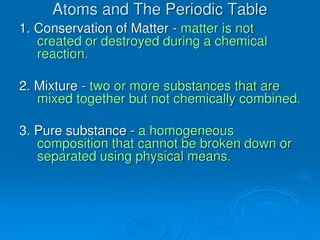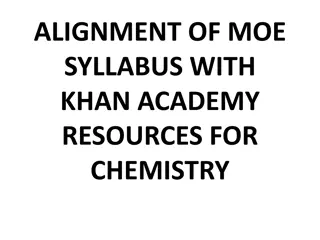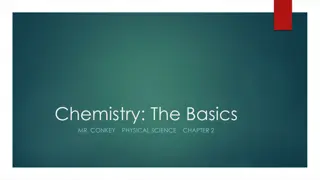Understanding Matter and its Classification in Chemistry
Matter is defined as anything that occupies space and has mass. It can be classified into solids, liquids, and gases, as well as pure substances and mixtures based on their composition. This overview covers the states of matter, Aristotle's four elements theory, and the classification of matter into pure substances and mixtures. The concept of homogeneous and heterogeneous mixtures is also explained.
Download Presentation

Please find below an Image/Link to download the presentation.
The content on the website is provided AS IS for your information and personal use only. It may not be sold, licensed, or shared on other websites without obtaining consent from the author. Download presentation by click this link. If you encounter any issues during the download, it is possible that the publisher has removed the file from their server.
E N D
Presentation Transcript
Chemistry Sept 20, 2019 P3 Challenge What is the definition of matter? (submit on slip of paper) Retrieve your test results.
Objectives and Agenda Objectives To distinguish solids, liquids and gases. To distinguish pure substances and mixtures, types of mixtures and types of pure substances. Agenda: Pogil Matter Classification Activity Introduction to States of Matter Matter Classification Chemical and Physical properties\changes (time permitting) Assignment: Complete Matter Classification Activity, Memorize element list (Complete the Chemical and Physical Properties and Changes Worksheet)
States / Phases of Matter Solid Definite volume, definite shape, incompressible Low atomic motion, very high density Liquid Definite volume, indefinite shape, incompressible Moderate atomic motion, high density Gas Indefinite volume, indefinite shape, compressible High atomic motion, low density
Aristotles Chemistry (300 BCE 1661 ) Aristotle s four elements correspond to both matter and energy. In the absence of atomic understanding, it s not a horrible theory. States of Matter refer to macroscopic observations so they have been around since Aristotle Four Elements Fire Earth (Solid) Water (Liquid) Air (Energy) Abandoned in 1661 with the publication of The Skeptical Chemist by Robert Boyle. (Gas)
Classification of Matter Besides identifying the state of matter (solid, liquid, gas) we can also classify matter according to its composition Distinctions to make Mixtures Pure substances Homogeneous Heterogeneous Elements Compounds
Classification of Matter Pure Substance = a sample of matter with a single uniform chemical composition Mixture = a sample of matter containing two or more substances, where these substances are not bonded (or joined) to each other and no chemical reaction occurs between the substances. Component substances (parts of a mixtures) are not in a fixed ratio (vary from sample to sample) keep their individual physical properties can be separated by mechanical means Ex: Sand in water
Types of Mixtures Homogeneous Mixture = a mixture with only one distinct phase (solid, liquid, gas) such that Uniform The different components of the mixture cannot be seen Heterogeneous Mixture = a mixture with two or more distinct substances and/or phases present Non-uniform The different components of the mixture can be seen
Observing mixtures Clear means you can see through it (NOT that it looks like water) Water is both clear and colorless. It is possible to be clear and red. Ex: Red cellophane, Cherry Koolaid. Cloudy means there is a solid present in the liquid. If a cloudy mixture settles over time, it s a suspension. If a cloudy mixture does not settle over time, it s a colloid. If a cloudy mixture becomes clear, that means the solid has dissolved and you now have a homogeneous solution.
Common Heterogeneous Mixtures Phases of matter Name of mixture Example liquid-liquid emulsion mayonnaise solid-liquid suspension muddy water gas-liquid aerosol bug spray gas-solid smoke smog
Types of Pure Substances Mixtures separated by physical means into components are pure substances. Decompose pure substances using chemical methods: reactivity with other substances, reaction to heat, light or electricity Element = Pure substance that cannot be broken down into simpler pure substances by any chemical means Compound = Pure substance that can be broken down into simpler pure substances (other compounds or elements) by chemical means.
Elements Practice quiz for all 51 Memory elements on 9/24 10 pt quiz for 30 random elements on 9/26 118 known, 91 naturally occurring, 27 synthetic elements Each element given a one or two letter symbol based on their name in English or Latin (first is capitalized) Organized on the periodic table Memorize the symbols for elements with Z 36 and a few others that are common: Zr, Ag, Sn, Sb, I, Xe, Ba, W, Pt, Au, Hg, Pb, Rn, U, Pu Remember, the symbol applies to both a single atom and a macroscopic sample of the element
Compounds Compounds are either crystalline or amorphous (salt/molecule, inorganic/organic) Law of constant composition / definite proportions All samples of a given compound contain exactly the same proportion of elements by mass. Organic Compounds far outnumber Inorganic Compounds even though they only involve a relatively few kinds of elements Organic compounds typically contain C, H, O, and/or N
Exit Slip - Homework Exit Slip: None What s Due? (Pending assignments to complete.) Matter Classification Activity if not yet done Memorize Element Symbols. Practice quiz next time on all 51 What s Next? (How to prepare for the next day) Read p4-8























